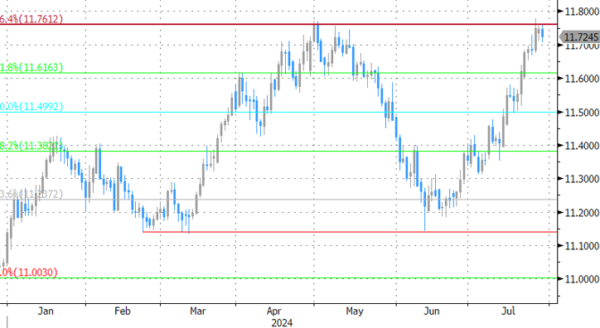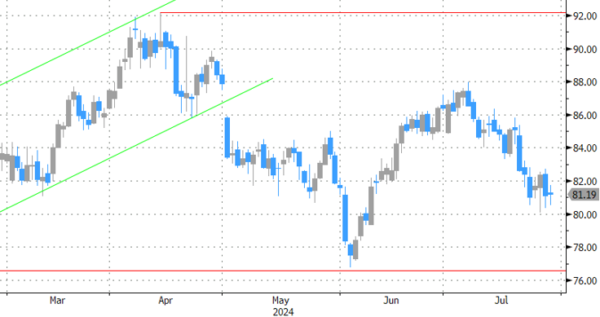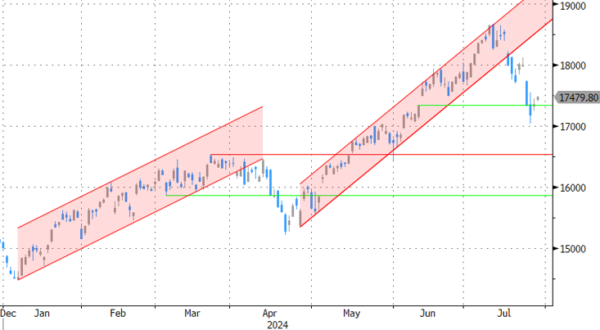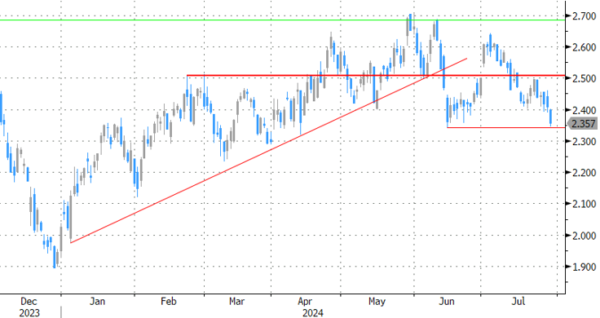Markets
Today has mostly been a waiting game in the run-up to an economic calendar that shifts into higher gear starting from tomorrow. The were few to no signs of worry about a potential escalation in the Gaza war after Israel retaliated over the weekend on what it said was a Hezbollah attack in the Golan Heights. Oil prices gapped higher at the open this morning but quickly pared gains to trade slightly lower on the day (< $81 per barrel). The constructive Asian equity sentiment didn’t spill over into European dealings though with the likes of the EuroStoxx50 shedding 0.3% in choppy trading. Stock markets in the US do open higher (in tech-heavy indices). Core bond yields extend their losing streak, confirming that south for the time being remains the path of least resistance. US Treasury yields drop between 0.4 (2-yr) and 3.4 (30-yr) bps with both the 2-yr and 10-yr tenor nearing first technical support areas (4.34%/July low and 4.14% respectively). German yields lose between 2.1 and 6.2 bps in a similar shift of the curve. Here too short and longer term maturities are either nearing or testing important support zones (eg. 2.34% June low for the 10-yr tenor). Markets are bracing for an imminent (Fed) or continuation (ECB) of the monetary easing cycle but are also adjusting their views on the economy after a string of disappointing or outright poor economic data. In the US, the 10-yr real yield has dipped sub 2% since mid-July.
The dollar gained the upper hand on currency markets, especially against an overall weak euro. EUR/USD for no apparent reason slid throughout the day from as high as 1.087 to 1.081 currently. The trade-weighted dollar index rose to its highest level since the June CPI undershoot, July 11. The greenback didn’t gain (much) against the Japanese yen though. USD/JPY stabilized around 153.9 for most of the day. Sterling showed some sharp intraday swings. EUR/GBP shortly after the European open jumped towards a high of 0.846 before paring gains almost as quickly. The pair is currently changing hands around 0.842, down from 0.8437 on Friday. We’ve seen no particular trigger for the moves but the upcoming Bank of England meeting is probably triggering some market nerves. Market implied probability for a cut dropped from over 70% end last week to less than 60% today.
News & Views
Sweden’s economy unexpectedly contracted in the second quarter of the year. A preliminary reading based on the monthly GDP indicator (using an incomplete dataset) showed GDP dropping 0.8% q/q vs an expected stagnation. It followed sharper-than-expected growth in Q1 of 0.7%. These Q1 figures illustrate the possible gap between the first and the final reading with its initial estimate being a 0.1% contraction. Since the numbers lie outside official statistics, Swedish Statistics does not offer details on growth composition. “The Swedish economy grew in June [0.9% m/m] but figures for the second quarter as a whole were weighed down by weak figures in April,” economist at Statistics Sweden Mattias Kain Wyatt added. Given the volatile nature of the monthly dataset and huge revision potential, Sweden’s currency chose not to react panicky. EUR/SEK is hovering sideways around 11.70+ with SEK trying to find a bottom after a heft slide since mid-June.
Belgian GDP grew 0.2% q/q in Q2 of this year, the National Bank of Belgium released today. The economy is now 1.1% bigger compared to the same period in 2023. Quarterly growth was the slowest since 2022Q4 while the yearly measure was the lowest since the huge upswing in the wake of the lockdowns being lifted. The preliminary estimate only contains a sectoral divide showing that rising value added in the services economy (+0.2% q/q) and especially construction (+1.1%) compensated for a -0.3% drop in the industry.
Graphs
EUR/SEK: Swedish currency unbothered by preliminary GDP release showing economy contracted 0.8% q/q
Brent oil’s “gap” higher in wake of Israeli-Gaza war developments evaporated almost immediately
Nasdaq is looking for a bottom after a tech-driven sell-off last week pushed it to the brink of a 10% correction
German 10-yr yield is testing important support area ahead of key data releases this week including GDP and CPI
















